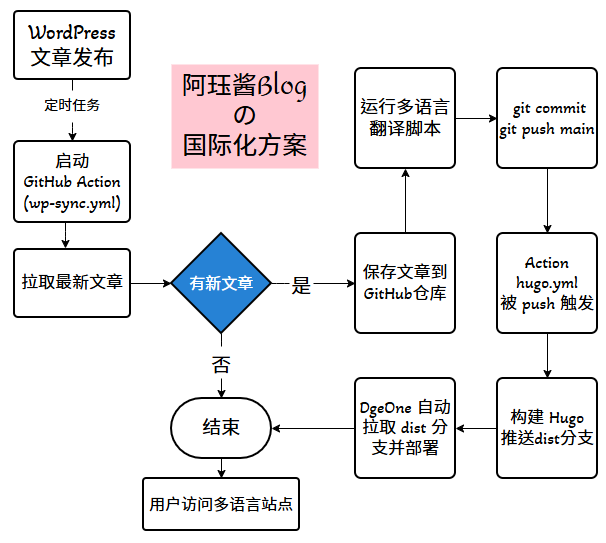开始前,我们先简单了解一下基本的概念,我大致归纳为以下几个点
什么是Web3.0,和区块链又有什么关系?(上回的文章不就派上用场了)
需求:开发一个基于Python的Web 3.0图片上传系统。这个系统将允许用户上传图片,并将图片存储在去中心化的网络上,同时记录交易信息在区块链上。
本就是写着玩的,想过要写成用户认证文件操作集成全套管理的,让他‘终将成为图片上传服务的最终解决方案’
实际下来却发现不是很实际,就作罢了,奈何我一直以来对图片这么执着
步骤概述
- 环境设置:使用Python开发,安装必要的Python库。
- IPFS集成:将图片上传到IPFS,获取图片的CID(Content Identifier)。
- 区块链集成:将IPFS CID记录在区块链上。
- Web接口:使用Flask创建一个Web接口,允许用户上传图片。
详细步骤
1. 环境设置
安装所需的Python库:
pip install flask web3 ipfshttpclient2. IPFS集成
IPFS(InterPlanetary File System)是一种点对点的文件存储协议。我们可以使用ipfshttpclient库来与IPFS网络交互。
首先,确保你已经安装并运行了IPFS节点。如果还没有安装IPFS,可以在IPFS官网找到安装指南。
以下是上传图片到IPFS的代码示例:
import ipfshttpclient
def upload_to_ipfs(file_path):
client = ipfshttpclient.connect('/ip4/127.0.0.1/tcp/5001')
res = client.add(file_path)
return res['Hash']3. 区块链集成
使用web3.py库将IPFS CID记录到区块链上。我们将以太坊(Ethereum)作为示例区块链。
以下是一个简单的智能合约示例,用于存储IPFS CID:
pragma solidity ^0.8.0;
contract IPFSStorage {
mapping(address => string[]) public userCIDs;
function storeCID(string memory cid) public {
userCIDs[msg.sender].push(cid);
}
function getCIDs() public view returns (string[] memory) {
return userCIDs[msg.sender];
}
}编译并部署该合约后,使用以下Python代码与智能合约交互:
from web3 import Web3
# 连接到以太坊节点
w3 = Web3(Web3.HTTPProvider('http://localhost:8545'))
# 合约地址和ABI(在部署合约后获取)
contract_address = 'YOUR_CONTRACT_ADDRESS'
contract_abi = 'YOUR_CONTRACT_ABI'
contract = w3.eth.contract(address=contract_address, abi=contract_abi)
def store_cid_on_blockchain(cid, account, private_key):
txn = contract.functions.storeCID(cid).buildTransaction({
'from': account,
'nonce': w3.eth.getTransactionCount(account),
'gas': 2000000,
'gasPrice': w3.toWei('50', 'gwei')
})
signed_txn = w3.eth.account.sign_transaction(txn, private_key=private_key)
txn_hash = w3.eth.sendRawTransaction(signed_txn.rawTransaction)
return txn_hash.hex()4. Web接口
使用Flask创建一个Web接口来上传图片。
from flask import Flask, request, jsonify
import os
app = Flask(__name__)
@app.route('/upload', methods=['POST'])
def upload_file():
if 'file' not in request.files:
return jsonify({'error': 'No file part'})
file = request.files['file']
if file.filename == '':
return jsonify({'error': 'No selected file'})
if file:
file_path = os.path.join('/path/to/save/uploads', file.filename)
file.save(file_path)
# 上传到IPFS
cid = upload_to_ipfs(file_path)
# 存储到区块链
account = 'YOUR_ETHEREUM_ACCOUNT'
private_key = 'YOUR_PRIVATE_KEY'
txn_hash = store_cid_on_blockchain(cid, account, private_key)
return jsonify({'cid': cid, 'transaction_hash': txn_hash})
if __name__ == '__main__':
app.run(debug=True)上传成功后会返回一个HASH的值,这个就是图片在ipfs上的ID。
本地网关访问:ipfs://QmVJGX3FJPZsAgGMtJZoTt14XBj8QKhPwaaP4UfCcvYaN2 、ipfs://QmRF9mejyfq89vAJ5yfsBbmVY3RUcLqfSsVTAmAbS8U2xD
外网网关:https://ipfs.crossbell.io/ipfs/QmVJGX3FJPZsAgGMtJZoTt14XBj8QKhPwaaP4UfCcvYaN2 、https://ipfs.crossbell.io/ipfs/QmRF9mejyfq89vAJ5yfsBbmVY3RUcLqfSsVTAmAbS8U2xD
智能合约
我们将使用Solidity编写智能合约,用solc编译器编译合约,并使用web3.py库部署合约到以太坊网络。
1. 编写智能合约代码
首先,创建一个Solidity文件(如IPFSStorage.sol),并编写你的智能合约代码:
// IPFSStorage.sol
pragma solidity ^0.8.0;
contract IPFSStorage {
mapping(address => string[]) public userCIDs;
function storeCID(string memory cid) public {
userCIDs[msg.sender].push(cid);
}
function getCIDs() public view returns (string[] memory) {
return userCIDs[msg.sender];
}
}2. 编译智能合约
要编译Solidity智能合约,我们可以使用solc编译器。你可以通过以下命令安装Solidity编译器:
npm install -g solc然后,使用以下命令编译智能合约:
solc --abi --bin IPFSStorage.sol -o build/这将生成两个文件:IPFSStorage.abi(合约的ABI)和IPFSStorage.bin(合约的字节码)。
3. 部署智能合约
使用web3.py库部署合约。确保你已经运行了一个以太坊节点(如使用Ganache本地开发环境)。
首先,安装web3.py:
pip install web3然后,编写并运行以下Python脚本来部署合约:
from web3 import Web3
# 连接到以太坊节点(使用Ganache本地节点为例)
w3 = Web3(Web3.HTTPProvider('http://127.0.0.1:7545'))
# 读取合约的ABI和字节码
with open('build/IPFSStorage.abi', 'r') as abi_file:
contract_abi = abi_file.read()
with open('build/IPFSStorage.bin', 'r') as bin_file:
contract_bytecode = bin_file.read()
# 设置部署账号和私钥(使用Ganache提供的账号)
deployer_account = '0xYourAccountAddress'
private_key = 'YourPrivateKey'
# 创建合约对象
IPFSStorage = w3.eth.contract(abi=contract_abi, bytecode=contract_bytecode)
# 构建交易
transaction = IPFSStorage.constructor().buildTransaction({
'from': deployer_account,
'nonce': w3.eth.getTransactionCount(deployer_account),
'gas': 2000000,
'gasPrice': w3.toWei('50', 'gwei')
})
# 签署交易
signed_txn = w3.eth.account.sign_transaction(transaction, private_key=private_key)
# 发送交易并获取交易哈希
txn_hash = w3.eth.sendRawTransaction(signed_txn.rawTransaction)
print(f'Transaction hash: {txn_hash.hex()}')
# 等待交易确认
txn_receipt = w3.eth.waitForTransactionReceipt(txn_hash)
print(f'Contract deployed at address: {txn_receipt.contractAddress}')总结
编译智能合约生成的ABI和字节码用于与合约交互,部署合约则涉及到创建交易、签署交易并将交易发送到以太坊网络。部署成功后,可以通过交易回执获取合约地址,并使用这个地址与合约进行交互。








最新评论